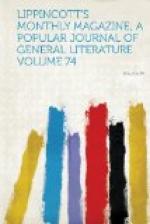The emerald has been a subject of controversy among the chemists and mineralogists, and its character, especially the cause of its beautiful color, is not clearly defined even at the present day. But that distinguished chemist, Professor Lewy of Paris, seems to offer, thus far, the most correct and plausible theory. Ten years ago he boldly asserted that the hue is not due to the oxide of chromium, and with this opinion he confronted such eminent men as Vauquelin, Klaproth and others of high rank in the scientific world. Not content with his researches in his laboratory in Paris, he resolutely crossed the ocean and sought the emerald in its parent ledges in the lofty table-lands of New Granada. Here he obtained new information of a geological character which goes far to strengthen his position. The experiments of M. Lewy indicate, if they do not prove, that the coloring matter of the emerald is organic, and readily destroyed by heat, which would not be the case if it was due to the oxide of chromium. All my own fire-tests with the Granada emerald corroborate the views of M. Lewy, for in every instance the gem lost its hue when submitted to a red heat.
Nevertheless, the recent researches of Woehler and Rose give negative results. These experienced chemists kept an emerald at the temperature of melted copper for an hour, and found that, although the stone had become opaque, the color was not affected. They therefore considered the oxide of chromium to be the coloring agent, without, however, denying the presence of organic matter. The amount of the oxide of chromium found by many chemists varies from one to two per cent., while Lewy and others found it in a quantity so small as to be inappreciable, and too minute to be weighed.
Before the ordinary blowpipe the emerald passes rapidly into a whitish vesicular glass, and with borax it forms a fine green glass, while its sub-species, the beryl, changes into a colorless bead: with salt of phosphorus it slowly dissolves, leaving a silicious skeleton.[A]
M. Lewy visited the mines at Muzo in Granada, and from the results of his analyses, together with the fact of finding emeralds in conjunction with the presence of fossil shells in the limestone in which they occur, he arrived at the conclusion that they have been formed in the wet way—deposited from a chemical solution. He also found that when extracted they are so soft and fragile that the largest and finest fragments can be reduced to powder by merely rubbing them between the fingers, and the crystals often crack and fall to pieces after being removed from the mine, apparently from loss of water. Consequently, when the emeralds are first extracted they are laid aside carefully for a few days until the water is evaporated.




